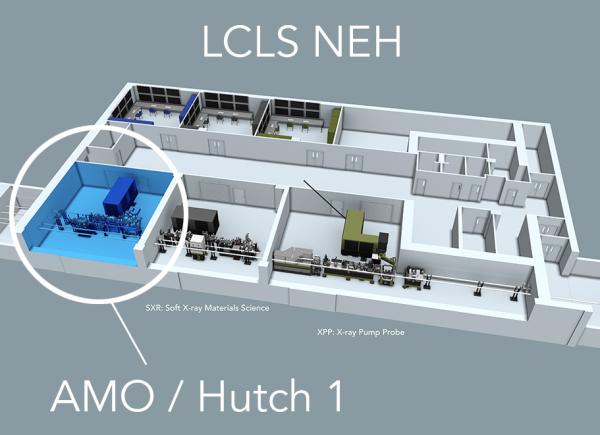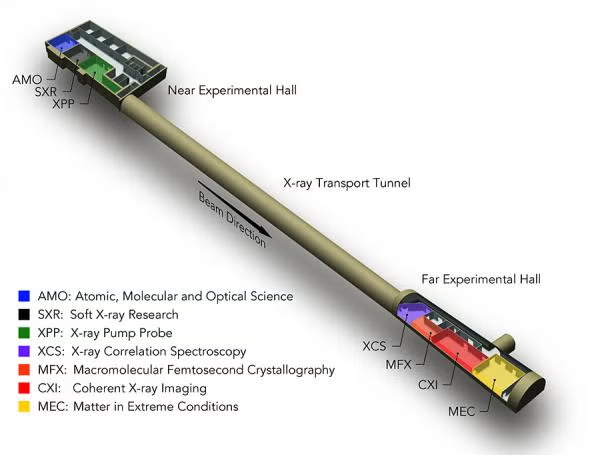AMO Overview
AMO Full Name
Atomic, Molecular and Optical Science Instrument
Short Description
The AMO instrument is situated on one of the soft X-ray branches of the LCLS that delivers intense ultra short pulses of X-rays from the FEL. Instrumentation is designed to minimize losses and deliver the maximum possible X-ray intensity to the interaction region. Gaseous targets of atoms, molecules, clusters, or nanoscale objects such as protein crystals or viruses are typically used in the AMO instrument with electron and ion spectrometers as well as large area detectors for X-ray diffraction measurements. Science performed with the AMO instrumentation includes fundamental studies of light-matter interactions in the extreme X-ray intensity of the LCLS FEL beam, time-resolved photoionization, X-ray diffraction of nanocrystals and single shot imaging of non-reproducible objects.
In order to maintain the high peak brightness of the LCLS X-ray pulse, a minimal set of optics is used to deliver the beam to the target in the AMO instrument. In addition to the three soft X-ray offset mirrors (SOMS) that deliver the beam to the soft X-ray branches, two planar-elliptically bent Kirkpatrick Baez mirrors are used to focus the beam to approximately ~5 µm2 in the first interaction region within the high-field physics chamber. The mirrors can be bent to various radii, allowing the focus to be moved along the beam or the size of the beam in the interaction region varied as desired by the experiment. At the more downstream interaction region in the Diagnostics chamber, foci of ~30-50 µm2 can be achieved.
A high powered synchronized optical laser is available for all experiments in the AMO instrument and a variety of wavelengths has been used for different experiments. An 800 nm beam is typically delivered to the hutch with wavelength conversion carried out in the hutch with doubling and tripling crystals for shorter wavelengths and an optical parametric amplifier (OPA) for longer wavelengths available. Additional lasers have been installed in the hutch (i.e. a Nd:YAG laser) for specific experiments, and all special cases should be discussed directly with hutch staff.
Scientific Goals
The interaction of ionizing radiation with matter has been a topic of much study since Hertz observed (1887) and Einstein described (1905) the photoelectric effect. While the mechanisms of excitation and ionization following the illumination of a sample with a weak beam of X-rays are well understood, little is known about the processes which occur when an intense beam of X-ray radiation strikes a target. Novel multi-electron processes are expected to occur and states of matter never before seen created. The goal of the AMO instrument is to study the interaction of the intense, short pulses of X-rays from the LCLS with the simplest forms of matter; atoms, molecules and clusters, to expand the understanding of which processes are important at different intensity regimes.
The extremely short pulses of X-rays from the LCLS provide a unique capability to study chemical processes at their natural time-scale. X-rays, such as those produced by the LCLS, interact with electrons in matter, exciting or ionizing them or scattering from them. Electron dynamics occur on the attosecond time-scale, much faster than the duration of the LCLS pulse. Nuclear dynamics (the motion of nuclei in a molecule) occur on the femtosecond time scales, however, a time scale that the LCLS is ideally suited to study, and the electronic structure of a molecule adjusts to the changing nuclear structure. Furthermore, photoionization of inner-shell electrons provide a site-specific probe of the electronic structure of a molecule, i.e. allowing electrons from a carbon atom to be differentiated from those of an oxygen atom. The LCLS is therefore a powerful tool for studying the motion of atoms in molecules reactions initiated by an external trigger (i.e., laser).
- Investigate multiphoton and high-field X-ray processes in atoms, molecules and clusters
- Multi-photon ionization/excitation in atoms/molecules/clusters
- Accessible intensity on verge of high-field regime
- Study time-resolved phenomena in atoms, molecules and clusters using ultrafast X-rays
- Inner-shell side band experiments
- Photoionization of aligned molecules
- Temporal evolution of state-prepared systems
AMO CONTACT INFO
Peter Walter
SXD Instrument Scientist
(650) 926-3997
pwalter@slac.stanford.edu
Stefan Moeller
SXD Instrument Scientist
(650) 926-5321
smoeller@slac.stanford.edu
AMO Control Room
AMO LOCATION



